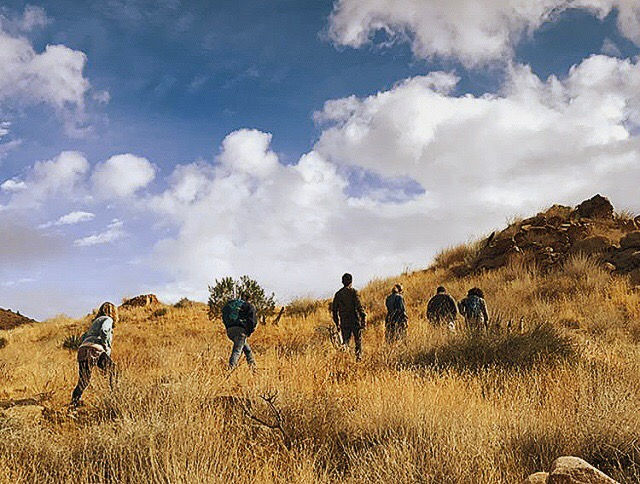Trillium ovatum, a conifer forest beauty.
- Christina Every Leaf Speaks Botanical Studies
- May 10, 2019
- 4 min read
Updated: Jun 15, 2019
I have been expanding my studies for a third year and this time I am focused on the study of field botany as I expand with herbalism. Being in a new area to me is a big change for this born and raised Southern California gal from the Sonoran Desert. One thing that comforts me during this transition as I study are the plants and all of the plant and fungi events happening up here. The PNW is just too damn damp for me, luckily it has been warmer than usual and sunny but when we are in the field in the understory of the conifers woods where it is dark, damp and cold when we are keying out plants and in lecture, I just miss my sunny warm and dry desert back home. You can bet I am working with a lot of nourishing nervine, drying and warming plants to help me. PLANTS WORK! I can see why folks get bummed out with the dark rainy days they get here and I definitely understand why folks run outside at the sign of a warm and sunny day.
One of the first plants I met on my first visit last spring to Oregon was Trillium ovatum common name Wake Robin. Now I am learning about this plant in the field and by far I think this is one of my favorite of flora here. It is a showy perennial that wakes as spring arrives in the coniferous woods. There are two others that peak thier sleepy heads as the snow begins to melt, Anemone lyallii common name Small Wind Flower and Viola glabella common name Stream Violet. One of my teachers, Howie Brounstein of Columbines School of Botanical Studies coined these three to rise at the start of spring as "THE BIG THREE". In early spring when you look around in the low elevation coniferous woods, you will find the first of flowers to appear are these three.
Trillium ovatum formally liliaceae (Lily family) now Melanthiaceae easily recognized by the showy large three white petals, three sepals, long slender stem and a whorl of three large triangular-oval leaves. When not in flower it is just as showy with the three large leaves and stem. As the white flower ages it turns in tone, starting at pink to dark violet almost magenta like and at the end of the flowers cycle it produces a fruit bearing seeds. It varies from short to tall and likes damp woodlands. The rhizome stores carbohydrates and in spring produces the flower and stem. The aerial parts of the Trillium spp. also help in replenishing the food reserves for the following year. So by removing the above ground parts we are impacting the future of the plant, especially when in fruit, which the fruit bear seeds, future Trilliums.
Trillium spp. rely on ants for dispersal of its seeds. The plant attracts ants with a lipid, protein rich structure called elaiosome. Other insects like yellow jackets, ground beetles and slugs are also attracted but it is the ants that help in dispersing most of the seeds. In fact there are other flora that depend on ants for helping them spread around like Dicentra formosa Bleeding Heart and Asarum spp. Wild Ginger. The interconnectedness of plants and critters and the web of life is fascinating and easily overlooked. So now when I am in the wild, I have a bit more appreciation for the ants.
There are many different species under the genera, Trillium, some are endangered on the USDA list and others are on the Species AT-RISK list under the United Plant Savers list, even though the Trillium I am speaking of is not listed on either list, it is a plant that when encountered we should admire it with and not pick. Due to habitat loss, clear cuts, development in forest have impacted Trillium ovatum. When one is in the woods one may think that it is not impacted and there is a large amount of Triullium, there may be many in that ONE space but it doesn't mean it is in abundance in other areas. So I tread lightly as I roam the woods also keeping an eye out for other plants like Calypso bulbosa.
On a recent trip my friend Candace Hunter from The Practical Herbalist and I were wandering the woods and I pointed out an aging Trillium, she described this process of aging as "perimenopause and menopause". It is like the life cycle of a maiden, mother and crone. It's a sweet way of looking at this transition of the plants life cycle.
I will close with a quote from botanist C. Leo Hitchcock...“The trilliums are rather easily grown, and T. ovatum in particular is an excellent addition to the native garden in the partial shade of such shrubs as rhododendrons, but it is a shame to dig them, especially since they grow readily from seeds. It has been said that the gathering of the flowering stem results in death of the plant, which is scarcely true, but it does rob the rhizome of stored food needed for the growth of the succeeding year’s flowering stem, often resulting in failure to flower. If the admonition was invented to discourage picking of the flowers, the statement should be that the picker, not the picked, will die, but justice rarely is so obvious." -C. Leo Hitchcock

































Comments